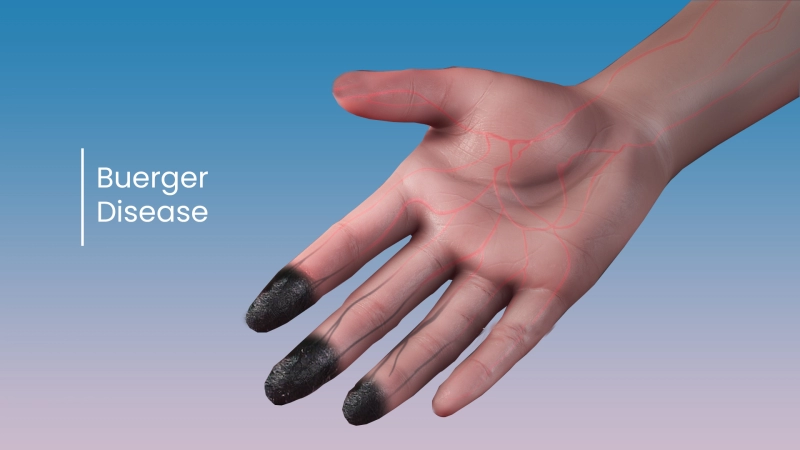

Buerger's Disease and the Efficacy of Spinal Cord Stimulation
 When the term "Buerger's Disease" is mentioned, it often sends an involuntary chill down the spines of those familiar with its ramifications. Often associated with smokers, this condition has earned a reputation for causing severe discomfort and, in extreme cases, necessitating the amputation of limbs. However, there's a beacon of hope on the horizon for patients grappling with the disease's debilitating nature. Spinal Cord Stimulation (SCS) has emerged as a groundbreaking treatment for Buerger's Disease, offering a novel approach to managing its symptoms and potentially saving patients' extremities.
When the term "Buerger's Disease" is mentioned, it often sends an involuntary chill down the spines of those familiar with its ramifications. Often associated with smokers, this condition has earned a reputation for causing severe discomfort and, in extreme cases, necessitating the amputation of limbs. However, there's a beacon of hope on the horizon for patients grappling with the disease's debilitating nature. Spinal Cord Stimulation (SCS) has emerged as a groundbreaking treatment for Buerger's Disease, offering a novel approach to managing its symptoms and potentially saving patients' extremities.
Understanding Buerger's Disease
Buerger's Disease, also known as Thromboangiitis Obliterans, is a rare disease of the blood vessels. It causes the blood vessels in the arms and legs to become inflamed, swollen, and narrowed, leading to reduced blood flow to the affected areas. The condition primarily affects the smaller blood vessels known as arterioles and venules. The reduced blood flow eventually leads to the development of blood clots, which can cause severe pain, tissue damage, and, in some cases, gangrene and amputation.
The exact cause of Buerger's Disease remains unknown, although its strong association with tobacco use suggests a clear risk factor. It occurs most commonly in young adult men who are heavy smokers, but it has been diagnosed in non-smokers, women, and the elderly as well. It is believed that an immune or autoimmune component may also play a role in the disease's development, but further research is required for conclusive evidence.
The Symptoms and Course of Buerger's Disease
The hallmark symptom of Buerger's Disease is intermittent claudication, which is a type of leg pain that occurs when a person walks or exercises and is relieved with rest. Other symptoms may include:
The progression of Buerger's Disease varies from person to person. Some will experience mild symptoms that do not worsen, while others will develop severe disease very quickly. Risk factors for severe disease include continued tobacco use and older age at the time of diagnosis.
Consequences and Complications of Buerger's Disease
The most severe complication of Buerger's Disease is the development of gangrene, a condition where tissue dies due to lack of blood flow or a serious infection. Gangrene often necessitates the amputation of the affected limb to prevent the spread of the necrosis and preserve overall health.
Buerger's Disease is not only physically disabling but can also have a significant impact on a person's quality of life. The chronic and severe pain associated with the disease often leads to psychological distress, depression, and a loss of independence. The social and economic implications for patients and their families can be profound.
Spinal Cord Stimulation as a Life-Changing Intervention
Spinal Cord Stimulation (SCS) has been a revolutionary treatment for chronic pain, and its potential in the management of Buerger's Disease cannot be understated. SCS is a minimally invasive procedure that uses a small device called a spinal cord stimulator to send low-voltage electrical current to the spinal cord, altering the way pain signals are perceived by the brain.
In the context of Buerger's Disease, SCS can offer multiple benefits. It has been shown to reduce the severe pain associated with the condition, potentially allowing patients to avoid or decrease their use of narcotic medications. More remarkably, SCS can also improve the vascularity of the affected limbs and, over time, increase blood flow, which may ultimately heal the areas of tissue damage and prevent amputation.
The Science Behind the Success
The underlying mechanism of SCS is complex but can be simplified into the manipulation of the nervous system's responses. The electrical stimulation provided by the device essentially hijacks the brain's perception of pain, focusing on the alleviation of discomfort. In doing so, SCS may indirectly influence blood vessel constriction and dilation, improving circulation to the extremities.
Several clinical studies have reported significant success in the use of SCS for Buerger's Disease. The devices have shown to not only alleviate pain but also to enhance the healing of ulcers and reduce the likelihood of amputation. Patients who have undergone SCS for Buerger's Disease have reported a marked improvement in their ability to perform activities of daily living, demonstrating the profound and multifaceted impact this treatment can have on their lives.
The Future of Buerger Disease Management
The potential for SCS in transforming the management of Buerger's Disease is immense. Not only does it address the immediate concern of pain control, but it also provides a pathway towards functional recovery and the preservation of limbs. It is a glimmer of hope for patients who face the daunting prospect of amputation and the associated challenges.
The field is ripe for further exploration, with ongoing research focusing on optimizing SCS techniques for maximum efficacy in the context of Buerger's Disease. The integration of SCS into comprehensive treatment plans and its earlier consideration in patient care could significantly improve outcomes and redefine the standard of care for this condition.
Patient and Professional Perspectives
While the potential of SCS in Buerger's Disease management is promising, it is imperative to consider the individual patient's needs and preferences. For professionals, understanding the nuances of each case and the patient's overall health is crucial in determining the appropriateness of SCS. Patients must be informed of the procedure's details, its benefits, and its associated risks to make well-considered decisions about their care.
The integration of SCS into a multidisciplinary approach that includes smoking cessation, pharmacological therapy, and vascular surgery can offer a comprehensive treatment package. Collaboration between pain specialists, vascular surgeons, and neurologists can ensure that patients with Buerger's Disease receive the most effective and tailored care.
Conclusion
Buerger's Disease may have a formidable reputation, but the advent of Spinal Cord Stimulation as a therapeutic option has redefined the narrative for many patients. By targeting the root cause of the pain and augmenting blood flow to the affected areas, SCS stands as a groundbreaking intervention with the potential to salvage limbs and restore dignity and functionality to those afflicted by the disease.
The horizon for Buerger's Disease treatment looks brighter than it has in years, with innovative approaches like SCS leading the charge. With continued research and an expanding knowledge base, the medical community is well-positioned to harness the full potential of this technology and improve the lives of countless individuals suffering from this challenging condition.
To delve deeper into Spinal Cord Stimulation surgery, you can click on this link or explore our dedicated Spinal Cord article under the Surgeries section.
last edited on 01.08.2024